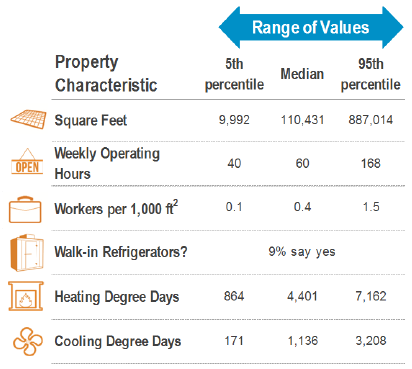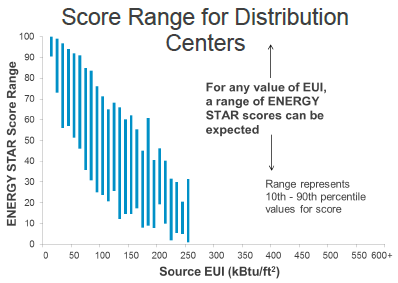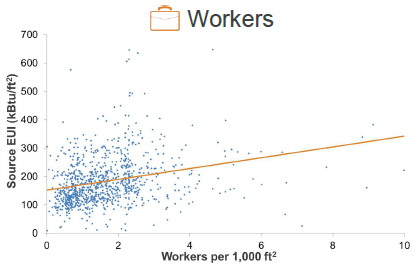Overview: ENERGY STAR DataTrends
 ENERGY STAR has recently released DataTrends—a sector-specific research and analysis series. The series currently includes 2-page fact sheets for each of 16 building types that are commonly tracked and rated using the DOE’s Portfolio Manager online software. In this blog, we will answer a few basic questions and make a couple of observations about the available data.
ENERGY STAR has recently released DataTrends—a sector-specific research and analysis series. The series currently includes 2-page fact sheets for each of 16 building types that are commonly tracked and rated using the DOE’s Portfolio Manager online software. In this blog, we will answer a few basic questions and make a couple of observations about the available data.
What are the Building Types that are discussed in DataTrends?
There are currently 16 included building types, which are:
| Distribution Center |
Non-Refrigerated Warehouse |
| Worship Facility |
K12 School |
| Dorms/Residence Halls |
Courthouse |
| Office (General) |
Hotel |
| Retail Store |
Senior Care Facility |
| Financial Office |
Medical Office |
| Bank Branch |
Hospital |
| Supermarket |
Wastewater Treatment Plant |
What are the primary property characteristics that are included?
Property characteristics vary by building type, but common characteristics include:
- Square Footage
- Weekly Operating Hours
- Workers / 1,000 sq. ft.
- Computers / 1,000 sq. ft.
- Heating Degree Days
- Cooling Degree Days
Each fact sheet provides a value for the 5th percentile, the median, and the 95th percentile of the sample:
What energy data is available?
 The fact sheets provide an ENERGY STAR score range comparison based on source Energy Use Index (EUI).
The fact sheets provide an ENERGY STAR score range comparison based on source Energy Use Index (EUI).
The EUI plus other variables affecting energy consumption are used to calculate your building’s ENERGY STAR rating.
Source EUI is also compared with significant building variables using scatter charts.

Again, the provided data varies by building type. For instance, Dorms/Residence Halls include a scatter chart relating rooms/1,000 sq. ft. to Source EUI (no correlation). The Courthouses building type includes a scatter chart relating the number of workers per 1,000 sq. ft. with the source EUI (marked correlation—see chart). Depending on the type of building, the scatter charts also demonstrate correlations with either heating degree days or cooling degree days and source EUI.
Where can I find the DataTrends studies online?
The individual and collected datasheets are available on the ENERGY STAR website (click to view). If you’re curious about how your buildings stack up against national benchmarks, we encourage you to explore the Portfolio Manager DataTrends resources. According to DataTrends, buildings that consistently benchmark energy use save an average of 2.4 percent per year.

 Best-in-class portfolio-level energy and utility bill data management and reporting.
Best-in-class portfolio-level energy and utility bill data management and reporting.
 Real-time energy and sustainability analytics for high-performance, net-zero buildings.
Real-time energy and sustainability analytics for high-performance, net-zero buildings.
 A holistic view of financial-grade scope 1, 2, and 3 carbon emissions data across your entire business.
A holistic view of financial-grade scope 1, 2, and 3 carbon emissions data across your entire business.
 Energy and sustainability benchmarking compliance software designed for utilities.
Energy and sustainability benchmarking compliance software designed for utilities.
 ENERGY STAR has recently released DataTrends—a sector-specific research and analysis series. The series currently includes 2-page fact sheets for each of 16 building types that are commonly tracked and rated using the DOE’s Portfolio Manager online software. In this blog, we will answer a few basic questions and make a couple of observations about the available data.
ENERGY STAR has recently released DataTrends—a sector-specific research and analysis series. The series currently includes 2-page fact sheets for each of 16 building types that are commonly tracked and rated using the DOE’s Portfolio Manager online software. In this blog, we will answer a few basic questions and make a couple of observations about the available data.
 The fact sheets provide an ENERGY STAR score range comparison based on source Energy Use Index (EUI).
The fact sheets provide an ENERGY STAR score range comparison based on source Energy Use Index (EUI).



